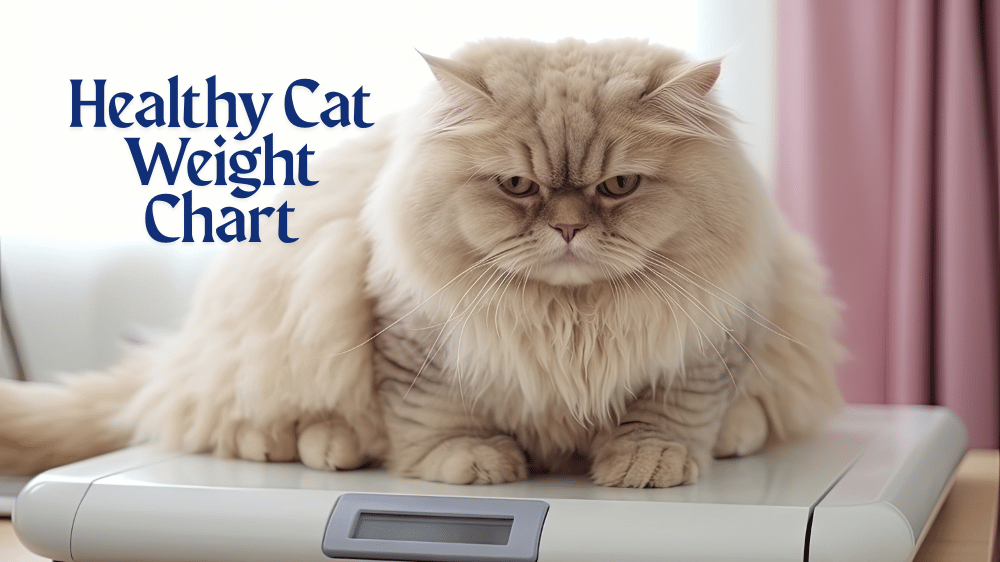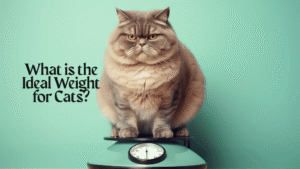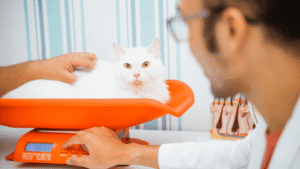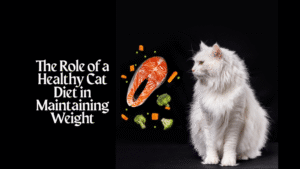A “healthy cat weight chart” is an essential tool for ensuring your feline maintains optimal health throughout every stage of life. From energetic kittens to aging seniors, tracking your cat’s weight using a reliable chart helps you identify what’s normal based on age, breed, and gender.
Understanding the ideal weight for cats and practicing consistent cat weight monitoring can prevent common weight issues in cats, such as obesity or undernourishment.
Whether you’re a first-time pet parent or a seasoned cat owner, this guide will walk you through everything you need to know about achieving and maintaining a healthy cat weight for a longer, more active life.
What is the Ideal Weight for Cats?
The ideal weight for cats can vary based on several factors, including age, breed, and gender. Generally, an adult domestic cat should weigh between 3.5 kg and 6.5 kg.
However, some weight issues in cats can lead to obesity or malnutrition, both of which can be harmful to your cat’s health.
Understanding cat weight by age is a key element of effective cat weight monitoring. For example, a 6-month-old kitten typically weighs between 2.7 kg and 3.2 kg, but the ideal weight for cats will be different for senior cats. Older cats may experience changes in their metabolism, leading to senior cat weight challenges that require extra attention.
Knowing your cat’s weight at each stage of life is critical for cat weight management and promoting a healthy cat diet. If your cat is gaining too much weight or losing weight rapidly, it could be a sign of underlying health problems. This is why cat health and weight should always be closely monitored.
Factors Affecting Healthy Cat Weight
Keeping your little tiger at a healthy cat weight isn’t only about following the “healthy cat weight chart”, it’s about understanding the factors that influence your cat’s weight. Here are the big ones:
Breed:
Clearly each breed will have a separate weight expectancy. For example, a Maine Coon cat generally will weigh more than a Siamese cat. These variances are natural genetic traits of the cat.
Sex:
Males cats are heavier than female cats. If you have a male and female cat, you’ll see the difference in weight.
Age:
Cat weight by age is also important when it comes to the perfect weight for cats. Kittens weigh less than full-grown cats as a rule, and older cats may gain or lose weight as a condition of aging.
Diet:
What you feed your feline friend has a direct relation to their health and weight. A healthy diet with adequate proteins and nutrients is important in keeping cat’s weight.
If you have seen some weight problems in cats, such as your cat feeling sluggish or getting fat, then your cat’s diet is what you need to re-evaluate. Your cat may be gaining weight because it is eating too much food, or the wrong kind of food. Talk to your vet, who can help you get the right mix of food and portion sizes to help keep your cat in that “healthy cat weight chart”.
The significance of a healthy cat diet cannot be overemphasized. A good quality diet for a cat does much more than help with cat weight management; it means a better quality of life, better mobility and good health overall. To help ensure your cat maintains his weight, a high-quality diet, along with regular exercise and playtime, is vital.
Healthy Cat Weight Chart by Age & Breed
Wondering what your cat’s ideal weight should be? Check out this handy chart that covers typical cat weight by age and common breeds. Keep track of your cat’s weight as they grow and see where they stand!
| Age | Ideal Weight (Kg) | Common Breeds |
| Newborn |
0.1 – 0.2 |
All Breeds |
| 3 Weeks Old |
0.3 – 0.6 |
All Breeds |
| 6 Months |
2.7 – 3.2 |
Siamese, Maine Coon |
| 1 Year |
3.5 – 5.5 |
Domestic Shorthair, Persian |
| 3-7 Years |
3.5 – 6.5 |
Ragdoll, British Shorthair |
| 8+ Years |
3.5 – 6.5 |
Sphynx, Bengal |
Factors Affecting Healthy Cat Weight
It is important to help your cat maintain a “healthy cat weight chart”. But do you even know what’s “normal” for your cat? Enter the “healthy cat weight chart.” But it’s not just about the numbers – it’s about knowing other things that can affect your cat’s weight.
Breed
It’s no secret that cats come in all shapes and size some just naturally bigger than others. For instance, a Maine Coon may weight between 8 and 10 kg and a Siamese might be between 2.5 to 3.5 kg.
Breed should also be taken into consideration when referring to the healthy cat weight chart. A healthy cat weight chart is not a one-size-fits-all, you need to take into account your cat’s specific genetics.
Gender
And it’s not just a matter of breed; male cats also tend to be heavier than females. Adult male cats may weight between 4 to 6.8 kg, while females may weigh 3.5-5.5 kg. You may want to keep that article in mind when you consult the “healthy cat weight chart” for your cat.
Age
Age of your cat It goes without saying that your cats age will significantly influence their weight. Kittens will be much lighter than adults, and older cats may gain and lose weight.
As your cats get older you will want to monitor their older cat weight closely, and use the “healthy cat weight chart” to see that they are not gaining or losing too much weight.
Health Conditions
It has not to do just with how much your cat eats. Any health issues plaguing your cat can have a serious impact on their weight. That’s why the “healthy cat weight chart” is an excellent diagnostic for spotting these changes early.
Diet and Lifestyle
A “healthy cat weight chart” is all-important for maintaining the ideal weight. Cats require protein, not carbohydrates! Overfeeding (and giving too many treats or too much human food.) can cause weight issues in cats so be sure to watch the portion sizes.
And that’s why being vigilant about feeding them the right amount of food is crucial if you want them to lose weight. (We also recommend having a look at our healthy cat weight chart where you can see where your cat should be, and you can keep their diet in balance according to that goal.)
The Role of a Healthy Cat Diet in Maintaining Weight
You’ve heard it before: “You are what you eat.” This is true for cats too! The diet of your cat has a direct effect on the “healthy cat weight chart”. There’s what you can do to ensure your cat stays on course:
Balanced Diet:
Can cats eat meat that you get from a quality pet food? A nutritious diet for cats includes high-quality protein, such as chicken, turkey, or fish along with essential vitamins and minerals from the various parts of an animal; and of course, healthy fats. It helps keep them in the range of healthy weight for cats, it is good for their overall health.
No Human Food:
While it may seem like a nice thing to do, human food can lead to weight gain and even obesity in cats. Don’t feed your cat table scraps, especially high-calorie food that isn’t formulated to meet a cat’s needs.
Portion Control:
Use the healthy cat weight chart to guide you on proper portion sizes. Overfeeding can result in weight issues in cats and underfeeding can lead to malnutrition. But also, keep to regular meals, and don’t overfeed your cat.
Water:
Water is essential! Cats who get enough water usually experience better digestion, healthier skin and weight management. Your cat must always have access to fresh water.
Monitoring and Managing Your Cat’s Weight
Monitoring your cat’s weight is a simple step to help keep your cat in the healthy weight for cats category. Frequently weighing your cat will allow you to catch anything early and keep your pet in tip-top health.
Weight Tracking
Weigh your cat regularly! Get a pet scale, keep an eye on what your pet’s weight is and match it up to the “healthy cat weight chart”. This will enable you to identify weight trends and respond before they get out of control.
Consult Your Vet
Your vet or your best source for healthy cat weight. Many things can make your cat gain or lose weight, but if it’s happening much faster than anticipated, a vet visit will help you get to the bottom of it.
Your vet can advise on the cat weight management who can recommend diets, help to rule out medical problems that may be contributing to your cat’s weight and provide general advice on how much and what to feed your cat.
The Importance of Monitoring
The healthy cat weight chart is another wonderful tool for determining your cat’s weight (it’s great for managing weight gain!). Regular check-ins will enable you to keep your cat within the target weight range. Tackling obesity in cats early can prevent a lot of frustration and help make your cat healthier for a longer time.
Signs Your Cat Might Be Overweight or Underweight
Understanding when your cat is overweight — or underweight — can be the key to their health. Look for the following signs, and refer to the Healthy Cat Weight Chart to stay the course.
Overweight Signs:
Inability to jump: In case your cat is unable to jump onto furniture or up the stairs,she may be carrying around a few extra pounds.
Potbelly: A large or thick layer of fat around the stomach is obvious sign of pussy-cat obesity.
Lack of Energy: Fat cats seem to have that “never-want-to-do-anything” attitude. They may not be as playful or energetic as they were.
You may want to weigh your cat and compare his weight with the recommendations on the Healthy Cat Weight Chart. If they’re overweight the time has come to revise their diet or maybe their exercise routine.
Underweight Signs:
Visible ribs: If you can see your cat’s ribs, and not by just poking around, she might be too thin.
Weakness: Thin cats can be weak and lack stamina.
Poor appetite: If your child had been eating well and now is not, it can be a sign of malnourishment or illness.
If your cat is too thin: Check the Healthy Cat Weight chart to see if they fall outside of the healthy range. Feed them appropriately and seek vet advice for appropriate balancing.
How to Use the Healthy Cat Weight Chart to Ensure Proper Health
One simple but effective way to monitor your cat’s health is by using the Healthy Cat Weight Chart. Here’s how you can use it:
Step-by-Step Guide:
1.Look up your cat’s age and breed on the Healthy Cat Weight Chart.
2.Find the weight range on the packaging to your cat’s specific stage of life.
3.Regularly weigh your cat: Weigh your cat regularly on a pet scale to monitor any weight changes.
4.Then, compare your cat’s weight to the chart: If they’re above or below the suggested healthy weight, it may be time to adapt.
The “Healthy Cat Weight Chart” to help pet owners stay ahead of the information game. Keeping track of how much your cat weighs routinely can help you catch early, any weight issues in your cat, and modify any needed their diet and / or exercise. It’s a convenient job to keep them in shape and well.
The Impact of Senior Cat Weight on Health
As your cat gets older, managing their senior cat weight becomes more important. Weight issues in senior cats can lead to serious health problems.
Weight Management in Senior Cats:
- Arthritis: Older cats often develop joint problems. Extra weight can make arthritis worse, leading to pain and difficulty moving.
- Obesity: Senior cats are at a higher risk of obesity in cats due to a slower metabolism. This can affect their heart, kidneys, and overall health.
As cats age, it’s crucial to monitor their cat weight management closely. The “Healthy Cat Weight Chart” can help guide you in ensuring your senior cat maintains a healthy weight to prevent joint and heart issues.
Conclusion
Maintaining a healthy cat weight is essential for your cat’s overall well-being. By using the Healthy Cat Weight Chart, you can easily monitor your cat’s growth and make adjustments to their diet and exercise routine when necessary. Regularly tracking your cat’s weight and consulting with your vet will help you provide them with the best care possible.
Keep your feline friend fit and healthy by following the ideal weight guidelines and ensuring they get the care they deserve!
FAQs About Healthy Cat Weight Chart and Cat Weight Management
Q1: How much should an adult cat weigh?
Answer:The ideal adult cat will weigh about 3.5kg to 6.5kg, depending on the breed and size.
Q2: How do I tell if my cat is overweight?
Answer:Look for symptoms like struggling to move, developing a potbelly or being too lethargic. Regular weight monitoring is important for adequate therapy.
Q3: What is the ideal diet to keep a cat at a good weight?
Answer:Cats should be fed a diet rich in protein and should contain key fatty acids and vitamins to aid in maintaining an ideal body weight.
Q4: What is the correct weight for my 6-month old kitten?
Answer:What to feed 6 month old kitten At 6 months old, your kitten should weigh between 2.7 kg to 3.2 kg, depending on the breed.
Q5: Are health issues related to my cat’s weight?
Answer:Yes, health problems such as hyperthyroidism, kidney disease and obesity can at least to some extent impact your cat’s weight.








